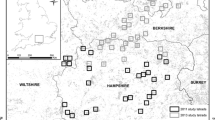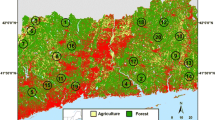Abstract
Introduction
Both fine scale patterns of vegetation and coarser scale landscape patterns affect bird community composition, but the relative importance of these two sets of patterns tends to be context dependent, varying by location and taxonomic group. Here, we explore the relative roles of landscape pattern and stand structure and composition in defining bird communities in 44 remnant oak stands in the Willamette Valley, Oregon. We focused on: (1) whether bird communities are influenced more by landscape (matrix and patch) patterns or stand composition and structure, and (2) in what contexts each of these spatial scales are more important. Specifically, we focused on how different groups of bird species (functional groups, synanthropic and non-synanthropic species, and individual species) were differentially influenced by landscape and more local patterns.
Methods
We conducted point counts to determine avian abundance, richness and evenness and categorized birds into functional groups based on diet and foraging tactics. We then used canonical correspondence analysis and generalized linear models to analyze overall community patterns, functional group diversity, synanthropic and non synanthropic species diversity and individual species’ abundances.
Results
Both local and landscape factors significantly influenced each group of avian species for every measure of diversity we tested, but their relative importance varied markedly. Local factors explained four times more variance than landscape factors for overall species diversity, whereas for functional groups, landscape factors explained one quarter to ten times the variance of local factors, depending on the group. For example, landscape factors were five times more important for the corvidae omnivores and ten times more important for the flycatchers than were local factors. By contrast, local factors were twice as important for seed eaters, frugivores and ground foragers, and bark foragers than were landscape patterns. We found the same high variability for individual species.
Conclusion
We conclude that the relative contribution of factors at different scales to the structuring of bird communities (as with the effects of so many other ecological processes and patterns) strongly depends on context—in this case, the specific group of species being considered.




Similar content being viewed by others
References
Akaike H (1973) Information theory and an extension of the maximum likelihood principle. In: Petro BN, Caski F (eds) Proceedings of the second international symposium on information theory. Akademiai Kiado, Budapest, pp 267–281
Altman B (2011) Historical and current distribution and populations of bird species in prairie-oak habitats in the Pacific Northwest. Northwest Sci 85:194–222. doi:10.3955/046.085.0210
Andrén H (1994) Effects of habitat fragmentation on birds and mammals in landscapes with different proportions of suitable habitat: a review. Oikos 71:355–366
Askins RA, Philbrick MJ (1987) Effect of changes in regional forest abundance on the decline and recovery of a forest bird community. Wilson Bull 99:7–21
Bender DJ, Contreras TA, Fahrig L (1998) Habitat loss and population decline: a meta-analysis of the patch size effect. Ecology 79:517–533
Beyer HL (2006) Hawth’s analysis tools v. 3.27. Sept 2007. Open source software available at http://www.spatialecology.com/htools/. Accessed June 2012
Bibby CJ, Burgess ND, Hill DA, Mustoe SH (2000) Bird census techniques, 2nd edn. Academic Press, London
Bollmann K, Weibel P, Graf RF (2005) An analysis of central Alpine capercaillie spring habitat at the forest stand scale. For Ecol Manag 215:307–318
Burnham KP, Anderson DR (2002) Model selection and multimodel inference: a practical information-theoretic approach, 2nd edn. Springer, New York
Butcher GS, Niven DK (2007) Combining data from the Christmas bird count and the breeding bird survey to determine the continental status and trends of North America birds. National Audubon Society, New York, p 34
Donnelly R, Marzluff JM (2006) Relative importance of habitat quantity, structure, and spatial pattern to birds in urbanizing environments. Urban Ecosyst 9:99–117. doi:10.1007/s11252-006-7904-2
Ehrlich PR, Dobkin DS, Wheye D (1988) The Birder’s Handbook: A Field Guide to the Natural History of North American Birds: including all species that regularly breed north of Mexico. Simon and Schuster, New York
Environmental Systems Resource Institute, ESRI (2009) ArcMap 9.2. ESRI (Environmental Systems Resource Institute), Redlands
Fernández-Juricic E (2004) Spatial and temporal analysis of the distribution of forest specialists in an urban-fragmented landscape (Madrid, Spain): implications for local and regional bird conservation. Landsc Urban Plan 69:17–32
Fitzpatrick JW (1981) Search strategies of tyrant flycatchers. Anim Behav 29:810–821
Fletcher RJ, Hutto RL (2008) Partitioning the multi-scale effects of human activity on the occurrence of riparian forest birds. Landscape Ecol 23:727–739. doi:10.1007/s10980-008-9233-8
Freemark K, Dunning JB, Hejl SJ, Probst JR (1995) A landscape ecology perspective for research, conservation, and management. In: Martin TE, Finch DM (eds) Ecology and management of neotropical migrant birds. Oxford University Press, New York, pp 381–421
Grinnell J (1917) The niche-relationships of the California Thrasher. Auk 34:427–433
Hagar JC, Stern MA (2001) Avifauna in oak woodlands of the Willamette Valley, Oregon. Northwest Nat 82:12–25
Hawrot RY, Nieme GJ (1996) Effects of edge type and patch shape on avian communities in a mixed conifer-hardwood forest. Auk 113:586–598
Hepinstall JA, Alberti M, Marzluff JM (2008) Predicting land cover change and avian community responses in rapidly urbanizing environments. Landscape Ecol 23:1257–1276. doi:10.1007/s10980-008-9296-6
Hodgkison S, Hero JM, Warnken J (2007) The efficacy of small-scale conservation efforts, as assessed on Australian golf courses. Biol Conserv 135:576–586
Huff MH, Bettinger KA, Ferguson HL, Brown MJ, Altman B (2000) A habitat-based point-count protocol for terrestrial birds, emphasizing Washington and Oregon. US Department of Agriculture, Forest Service, Pacific Northwest Research Station, Portland
Huff MH, Seavy NE, Alexander JD, Ralph CJ (2005) Fire and birds in maritime Pacific Northwest. Stud Avian Biol 30:46
Jaksić FM, Medel RG (1990) Objective recognition of guilds: testing for statistically significant species clusters. Oecologia 82:87–92
James FC, Shughart HH (1970) On understanding quantitative surveys of vegetation. Audubon Field Notes 24:727–736
Jensen JR (2004) Chapter 13: thematic map accuracy assessment. In: Introductory digital image processing: a remote sensing perspective, 2nd edn. Prentice Hall, Upper Saddle River, pp 495–515
Johnston RF (2001) Synanthropic birds of North America. In: Marzluff JM, Bowmann R, Donnelly R (eds) Avian ecology and conservation in an urbanizing world. Kluwer Academic Publishers, Norwell, pp 49–68
MacArthur RH, MacArthur JW (1961) On bird species diversity. Ecology 42:594–598
Marzluff J (ed) (January 2014) Personal communication. In: Urban Ecosystems (in press)
Moss D (1978) Diversity of woodland song-bird populations. J Anim Ecol 47:521–527
NatureServe (2005) International ecological classification standard: terrestrial ecological classifications. Oregon ecological systems 2008. Raster digital data set created for use in Northwest ReGap. University of Idaho. Available at http://gap.uidaho.edu/index.php/nw-gap/
Noss RF, LaRoe ET, Scott JM (1995) Endangered ecosystems of the United States: a preliminary assessment of loss and degradation. National Biological Service, Moscow, p 76
Oksanen J (2011) Multivariate analysis of ecological communities in R: vegan tutorial. http://cc.oulu.fi/~jarioksa/opetus/metodi/vegantutor.pdf. Accessed June 2012
Oksanen J (2014) Cluster analysis: tutorial with R. http://cc.oulu.fi/~jarioksa/opetus/metodi/sessio3.pdf. Accessed June 2012
Oksanen J, Blanchet FG, Kindt R, Legendre P, Minchin PR, O'Hara RB, Simpson GL, Solymos P, Stevens MHH, Wagner H (2011) Vegan: community ecology package. R package version 2.0-2 November 2014. Open source software available at http://cran.r-project.org/web/packages/vegan/index.html. Accessed June 2012
Palmer MW (1993) Putting things in even better order: the advantages of canonical correspondence analysis. Ecology 74:2215–2230. doi:10.2307/1939575
Poole A (2005) The birds of North America online. Cornell Laboratory of Ornithology, Ithaca. http://bna.birds.cornell.edu/BNA/. Accessed June 2012
Prugh LR, Hodges KE, Sinclair ARE, Brashares JS (2008) Effect of habitat area and isolation on fragmented animal populations. Proc Natl Acad Sci USA 105:20770–20775. doi:10.1073/pnas.0806080105
R Development Core Team (2010) R: a language and environment for statistical computing. R Foundation for Statistical Computing, Vienna
Riitters KH, O’neill RV, Hunsaker CT, Wickham JD, Yankee DH, Timmins SP, Jones KB, Jackson BL (1995) A factor analysis of landscape pattern and structure metrics. Landscape Ecol 10:23–39
Robbins CS, Sauer JR, Greenberg RS, Droege S (1989) Population declines in North American birds that migrate to the Neotropics. Proc Natl Acad Sci USA 86:7658
Roberts LJ (2001) Habitat and landscape associations of bird populations in the Nicolet National Forest, Wisconsin. University of Wisconsin, Green Bay
Robinson SK, Thompson FR III, Donovan TM, Whitehead DR, Faaborg J (1995) Regional forest fragmentation and the nesting success of migratory birds. Science 31:1987–1990
Sekercioglu CH (2006) Increasing awareness of avian ecological function. Trends Ecol Evol 21:464–471
Smith CM, Wachob DG (2006) Trends associated with residential development in riparian breeding bird habitat along the Snake River in Jackson Hole, WY, USA: implications for conservation planning. Biol Conserv 128:431–446. doi:10.1016/j.biocon.2005.10.008
Ter Braak CJF (1986) Canonical correspondence analysis: a new eigenvector technique for multivariate direct gradient analysis. Ecology 67:1167–1179
Wiens JA (2008) Habitat fragmentation: island v landscape perspectives on bird conservation. Ibis 137:S97–S104
Zar JH (1998) Biostatistical analysis, 4th edn. Prentice Hall, Upper Saddle River
Acknowledgments
We gratefully acknowledge support for this research from the National Science Foundation’s Coupled Natural–Human Systems Program. The authors also thank Aaron Wirsing and John Marzluff; Bob Altman for guidance on field work; Monte Mattsson and Candace Fallon for assistance in the field; and many people who helped identify and provide access to the field sites.
Author information
Authors and Affiliations
Corresponding author
Electronic supplementary material
Below is the link to the electronic supplementary material.
Rights and permissions
About this article
Cite this article
Galitsky, C., Lawler, J.J. Relative influence of local and landscape factors on bird communities vary by species and functional group. Landscape Ecol 30, 287–299 (2015). https://doi.org/10.1007/s10980-014-0138-4
Received:
Accepted:
Published:
Issue Date:
DOI: https://doi.org/10.1007/s10980-014-0138-4




